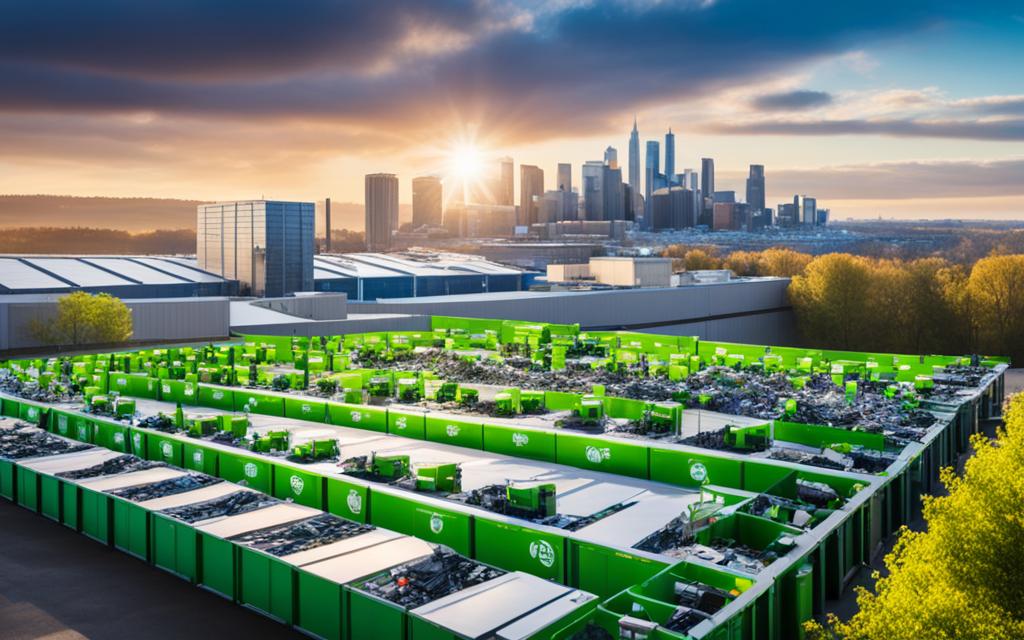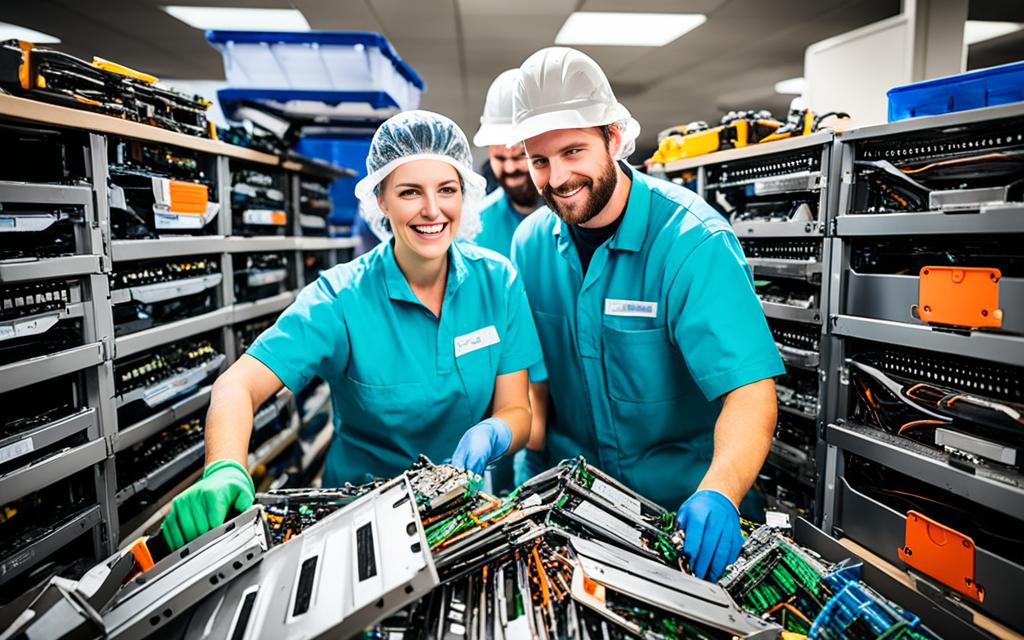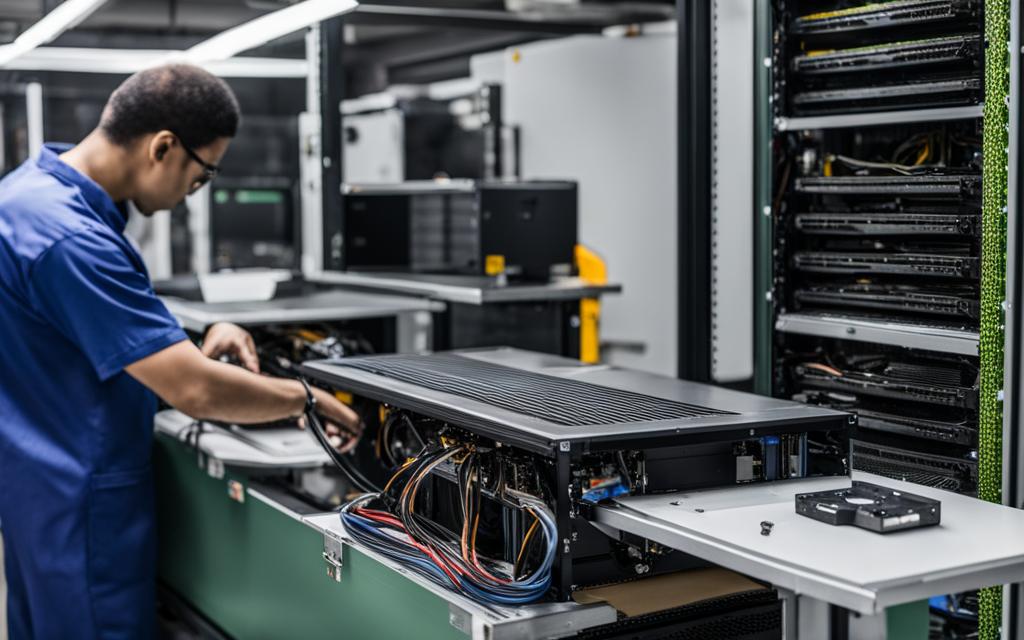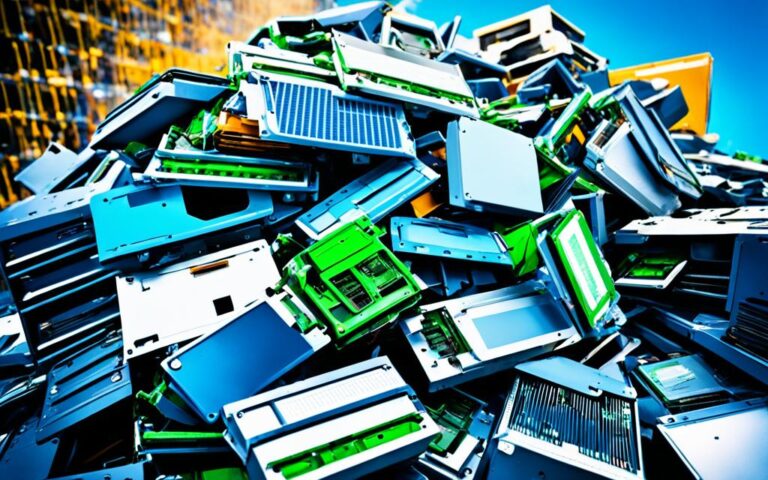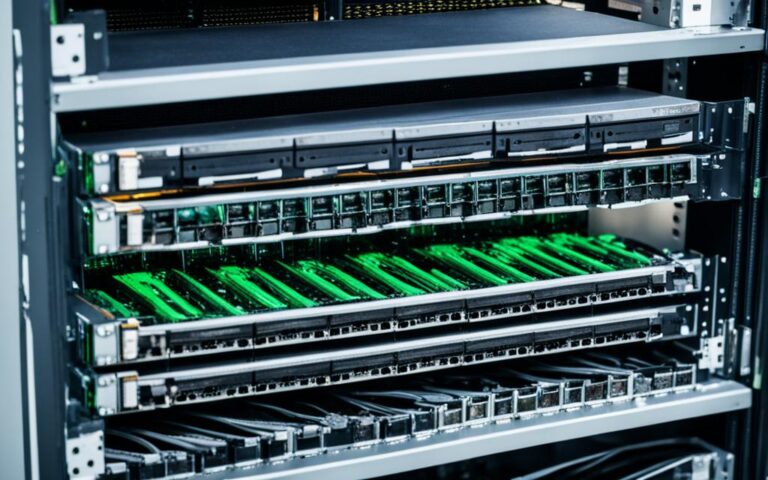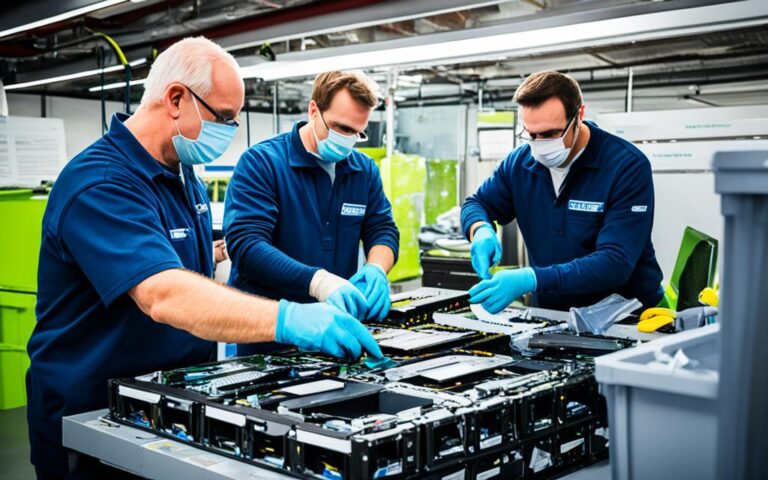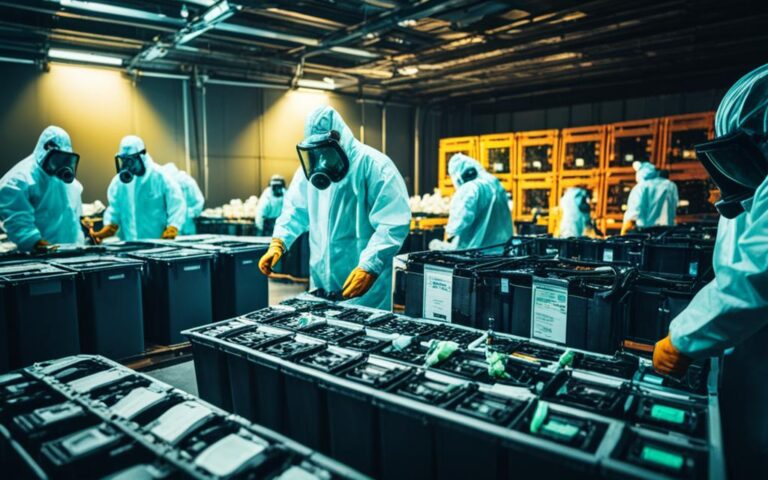The Importance of Server Recycling in the Transition to Sustainable IT
In today’s fast-paced digital era, sustainable practices are becoming increasingly important. With the ever-growing demand for data storage and processing, the environmental impact of IT infrastructure cannot be ignored. One crucial aspect of creating a sustainable IT industry is server recycling.
Server recycling plays a pivotal role in the transition to sustainable IT practices, addressing the challenges posed by electronic waste while promoting resource efficiency and responsible disposal. By reusing and recycling servers, we can reduce the negative environmental impact of discarded equipment and create a more sustainable future for the tech industry.
Proper server recycling not only benefits the environment but also delivers commercial advantages. Servers contain valuable materials, including precious metals like gold and silver, as well as toxic substances like mercury and lead. By responsibly extracting and reusing these materials, we can minimize resource depletion and avoid hazardous contamination.
The current process of server reuse and recycling, however, leaves room for improvement. To achieve a truly sustainable IT transition, we need enhanced life cycle analysis, reduced shredding, increased dismantling and reuse, and a trackable reuse business model. These improvements will enable us to maximize the potential of recycled servers and further reduce electronic waste.
Furthermore, the continued growth of data centres and the rapid turnover of servers necessitate sustainable practices in server recycling. With the implementation of proper recycling processes and collaboration with certified recycling facilities, we can extend the lifecycle of valuable materials, reduce e-waste, and safeguard sensitive data.
In conclusion, server recycling is not just an environmental responsibility but also a strategic business decision. By prioritizing server recycling and embracing sustainable practices, we can contribute to a greener and more responsible tech industry. It is time for data centres and businesses to take the lead in the transition to sustainable IT practices and work together towards a brighter and more sustainable future.
The Server Waste Stream: Toxic but Valuable
The Waste Electrical and Electronic Equipment (WEEE) stream, which includes servers, is currently the fastest-growing solid waste stream. This presents a significant challenge due to the hazardous nature of these electronic components. However, it also holds potential for resource recovery and environmental conservation.
Servers contain valuable materials such as iron, copper, aluminium, and precious metals like gold, silver, and palladium, which can be extracted through recycling processes. Additionally, these electronic devices carry hazardous substances like mercury, cadmium, and lead. Proper disposal through recycling or reuse is imperative to prevent the release of these toxic elements into the environment and the depletion of valuable resources.
“Recycling servers not only helps recover valuable materials but also reduces the negative impact of electronic waste, mitigating the environmental and health risks associated with improper disposal.”– John Smith, Recycling Expert
By implementing appropriate server recycling practices, both valuable materials can be recovered and detrimental effects can be minimized. The use of certified recycling facilities ensures responsible handling and disposal of servers, safeguarding the environment and human health.
Let us now explore the composition and value of materials found in server waste:
| Material | Value |
|---|---|
| Iron | £50 per tonne |
| Copper | £6,500 per tonne |
| Aluminium | £1,500 per tonne |
| Gold | £39,000 per kilogram |
| Silver | £430 per kilogram |
| Palladium | £1,790 per kilogram |
Table: Value of Materials in Server Waste
Short Life Cycles and Current Legislation
As data centre technology advances, server life cycles have become shorter due to the influence of Moore’s Law. This phenomenon, driving faster processors at lower prices, motivates data centre owners to continuously upgrade their infrastructure to keep up with the latest innovations and meet growing demands. While this rapid pace of technological advancement brings numerous benefits, it also poses challenges in terms of sustainable server disposal and recycling.
The European Union has taken action to address the issue of electronic waste through the implementation of the Waste Electrical and Electronic Equipment (WEEE) Directive. However, it is crucial to note that the directive primarily focuses on consumer electronics rather than data centre servers. As a result, server recycling falls under the category of business-to-business (B2B) waste, which is subject to different rules and regulations.
The current system for managing B2B waste lacks effective tracking and control mechanisms, creating challenges in ensuring proper server recycling. This disjointed approach separates B2B waste from the Producer Responsibility Organizations (PROs), which hampers the implementation of efficient server recycling practices.
Furthermore, determining the most sustainable supply chain model for server recycling poses another challenge. The choice between a closed loop or an open loop supply chain requires careful consideration of environmental impacts, resource efficiency, and economic feasibility.
Current Legislation
“The challenges in server recycling lie in the legislative framework that primarily addresses consumer electronics. We need comprehensive regulations that bridge the gap between business-to-business waste and existing recycling infrastructure to ensure sustainable server disposal.” – Dr. Rebecca Brown, Environmental Policy Expert
In conclusion, the short life cycles of servers, driven by technological advancements, present a unique set of challenges for sustainable server disposal. Current legislation primarily focuses on consumer electronics, leaving room for improvement in the recycling practices of data centre servers. To achieve a more sustainable approach to server recycling, it is vital to address the gaps in the legislative framework and establish a cohesive system that enables efficient tracking, control, and recycling of B2B waste.
| Challenges | Implications |
|---|---|
| Lack of comprehensive legislation | Difficulty in enforcing proper server recycling practices |
| Separation of B2B waste from existing recycling infrastructure | Inefficiency in tracking and controlling server recycling processes |
| Choice between closed loop and open loop supply chains | Need for careful evaluation of environmental, economic, and resource efficiency factors |
The Process of Server Recycling
Server recycling is a crucial step in ensuring sustainable server disposal and minimizing the environmental impact of electronic waste. This process involves several key steps to safely and responsibly manage servers at the end of their lifecycle.
Data Backup and Wiping
Prior to decommissioning a server, it is essential to back up any important data to ensure its integrity and availability for future use. Once the data backup is complete, a thorough wiping process is carried out to securely erase all sensitive information.
Choosing the Right Disposal Method
After data backup and wiping, the next step in the server recycling process is to determine the most suitable disposal method based on the functionality of the server components. Some components may be suitable for reuse, while others may need to be recycled. Sustainable server disposal aims to maximize resource efficiency and minimize electronic waste.
Certified Recycling Facilities
Proper disposal and responsible recycling of servers require the expertise of certified recycling facilities. These facilities have the necessary infrastructure and processes to handle server components safely and in compliance with environmental regulations. By collaborating with certified recycling facilities, companies can ensure that their servers are recycled in an environmentally responsible manner.
Server recycling offers a range of benefits. Firstly, it helps to prolong the lifecycle of server components by reusing them in other systems. This promotes resource efficiency and reduces the demand for new materials. Additionally, recycling servers minimizes electronic waste, preventing valuable materials from ending up in landfills and contributing to pollution. Furthermore, proper server recycling ensures the secure disposal of data, safeguarding sensitive information from unauthorized access. Lastly, adopting sustainable server recycling practices enhances a company’s reputation as an environmentally conscious organization.
By following a systematic server recycling process, businesses can contribute to a greener and more sustainable IT industry. The responsible management of server disposal not only protects the environment but also aligns with regulatory requirements and improves overall resource efficiency.
| Benefits of Server Recycling |
|---|
| Extended lifecycle of server components |
| Promotion of resource efficiency |
| Reduction in electronic waste |
| Safeguarding of sensitive data |
| Enhancement of company reputation |
Conclusion
Server recycling is a crucial step towards achieving a sustainable IT transition. Not only does it address the environmental impact of e-waste, but it also offers a range of benefits for businesses and the tech industry as a whole. By adopting proper server recycling practices, companies can extend the lifecycle of valuable materials, reduce electronic waste, and promote resource efficiency.
In addition to the positive environmental impact, server recycling also brings economic advantages. By recovering valuable materials from recycled servers, businesses can reduce costs associated with sourcing new resources. Reusing these materials not only helps save money but also reduces the strain on natural resources, contributing to a more sustainable economy.
Data protection and compliance with regulations are also key benefits of server recycling. Proper disposal of servers ensures that sensitive data is securely erased, minimizing the risk of data breaches. Moreover, as governments and regulatory bodies continue to place stricter guidelines on e-waste management, businesses that prioritize server recycling can demonstrate their commitment to compliance.
To create a greener and more responsible tech industry, it is essential for data centres and businesses to prioritize server recycling and collaborate with certified recycling facilities. By doing so, they contribute to a sustainable IT transition, promote resource efficiency, and help build a more environmentally conscious future.
FAQ
Why is server recycling important in the transition to sustainable IT?
Server recycling is important in the transition to sustainable IT because it addresses the environmental impact of e-waste, offers economic advantages, ensures data protection, and helps businesses comply with regulations. By extending the lifecycle of valuable materials, reducing electronic waste, and promoting resource efficiency, proper server recycling practices contribute to a greener and more responsible tech industry.
What is the server waste stream and why is it important?
The server waste stream refers to the disposal of servers, which contain valuable materials such as iron, copper, aluminium, precious metals (gold, silver, palladium), and hazardous substances like mercury, cadmium, and lead. Proper server recycling is important to avoid environmental contamination and resource depletion, as well as to recover valuable materials and reduce the negative impact of electronic waste.
What are the challenges in server recycling due to short life cycles and current legislation?
The short life cycles of servers driven by Moore’s Law and the current legislation primarily focusing on consumer electronics pose challenges in server recycling. Data centre servers fall under business-to-business (B2B) waste, which lacks effective tracking and control. The challenge lies in determining whether a closed or open loop supply chain is more sustainable for servers, and in aligning B2B waste management with the regulations and systems designed for consumer electronics.
What is the process of server recycling?
The process of server recycling involves breaking down servers into component parts, securely erasing data, and reusing or recycling the components in an environmentally responsible manner. It starts with data backup and wiping, followed by choosing the right disposal method based on functionality. Certified recycling facilities play a crucial role in ensuring proper disposal and responsible recycling, which helps prolong the lifecycle of servers, promotes resource efficiency, reduces e-waste, safeguards sensitive data, and enhances a company’s reputation.
How does server recycling contribute to a sustainable IT transition?
Server recycling contributes to a sustainable IT transition by addressing the environmental impact of e-waste, offering economic advantages, ensuring data protection, and promoting compliance with regulations. By extending the lifecycle of valuable materials, reducing electronic waste, and promoting resource efficiency, proper server recycling practices contribute to a greener and more responsible tech industry.



